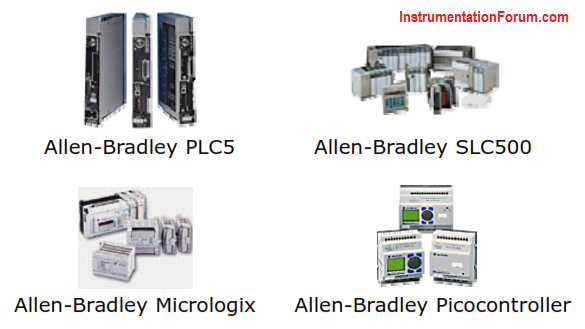A PLC is a user-friendly, microprocessor based specialized computer that carries out control functions of many types and levels of complexity.
Its purpose is to monitor crucial process parameters and adjust process operations accordingly.
Used extensively because of the PLC
– Is easy to set up and program
– Behaves predictably
– Ruggedized
It can be programmed (to a degree), controlled, and operated by a person unskilled in operating (programming) computers.
Essentially, a PLC’s operator draws the lines and devices of ladder diagrams with a keyboard/mouse onto a display screen.
The resulting ladder diagram is converted into computer machine language and run as a program.

PLC basics
Some PLCs are
– integrated into a single unit (Picocontroller),
– whereas others are modular (PLC5, SLC500)
– The Micrologix product lies somewhere between the PLC5 and the Picocontroller
Integrated PLCs are sometimes called brick PLCs because of their small size
– These PLCs have embedded I/O (i.e. the I/O is a part of the same unit as the controller itself)
– Modular PLCs have extended I/O
Components in a PLC system
CPU module, containing the processor and memory
Input and output modules, to allow the PLC to read sensors and control actuators – A wide variety of types are available
Power supply for the PLC, and often sensors and low power actuators connected to I/O modules
A rack or bus so the PLC can exchange data with I/O modules.
Additional PLC components
A programming unit is necessary to create, edit and download a user program to the PLC
Additional components can include:
– Network interfaces: to allow PLCs to function in a networked environment
– Communication adapters for remote I/O devices: so I/O devices do not have to be physically close to the CPU module
– Operator interface devices: allow monitoring and/or data entry by operators.
Definition And History Of The PLC
The first PLC systems evolved from conventional computers in the late 1960s and early 1970s. These first PLCs were installed primarily in automotive plants.
Traditionally, the auto plants had to be shut down for up to a month at model changeover time.
The early PLCs were used along with other new automation techniques to shorten the changeover time.
PLC Advantages
Flexibility
In the past, each different electronically controlled production machine required its own controller; 15 machines might require 15 different controllers.
Now it is possible to use just one model of a PLC to run any one of the 15 machines.
Furthermore, you would probably need fewer than 15 controllers, because one PLC can easily run many machines.
Each of the 15 machines under PLC control would have its own distinct program (or a portion of one running program).
Large Quantities of Contacts
The PLC has a large number of contacts for each coil available in its programming.
Suppose that a panel-wired relay has four contacts and all are in use when a design change requiring three more contacts is made.
Time would have to be taken to procure and install a new relay or relay contact block.
Using a PLC, however, only three more contacts would be typed in.
Contacts are now a “software” component
Visual Observation
A PLC circuit’s operation can be seen during operation directly on a CRT screen.
The operation or mis-operation of a circuit can be observed as it happens.
Logic paths light up on the screen as they are energized.
Troubleshooting can be done more quickly during visual observation.
Documentation
An immediate printout of the true PLC circuit is available in minutes, if required.
There is no need to look for the blueprint of the circuit in remote files.
The PLC prints out the actual circuit in operation at a given moment.
Often, the file prints for relay panels are not properly kept up to date. A PLC printout is the circuit at the present time; no wire tracing is needed for verification.
PLC Tutorials
Read the below article.